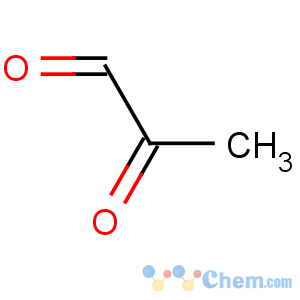Title: Methylglyoxal
CAS Registry Number: 78-98-8
CAS Name: 2-Oxopropanal
Synonyms: pyruvaldehyde; 2-ketopropionaldehyde; acetylformaldehyde
Molecular Formula: C3H4O2
Molecular Weight: 72.06
Percent Composition: C 50.00%, H 5.60%, O 44.41%
Line Formula: CH3COCHO
Literature References: Physiological metabolite formed by the fragmentation of triosephosphates and by the metabolism of acetone; synthesized by microorganisms. Also occurs in a variety of foods and beverages such as coffee. Reacts with nucleic acids and proteins under physiological conditions serving as a signal for their degradation. Prepn: H. v. Pechmann,
Ber. 20, 3213 (1887); H. O. L. Fischer, C. Taube,
ibid. 57, 1502 (1924);
eidem, ibid. 59, 857 (1926); M. W. Kellum
et al., Anal. Biochem. 85, 586 (1978). GC determn in food and biological samples: S. Ohmori
et al., J. Chromatogr. 415, 221 (1987). Review of natural occurrance and metabolism in microorganisms: Y. Inoue, A. Kimura,
Adv. Microb. Physiol. 37, 177-227 (1995). Review of physiological significance and role in pathogenesis: P. J. Thornalley,
Gen. Pharmacol. 27, 565-573 (1996).
Properties: Clear, yellow liquid, pungent odor. bp760 72°. d24 1.0455.
nD17.5 1.4002. Hygroscopic. Polymerizes very readily, forming a brittle, resinous mass. Sol in water and alcohol, giving colorless solns.
Boiling point: bp760 72°
Index of refraction: nD17.5 1.4002
Density: d24 1.0455
Derivative Type: Oxime
see Isonitrosoacetone

